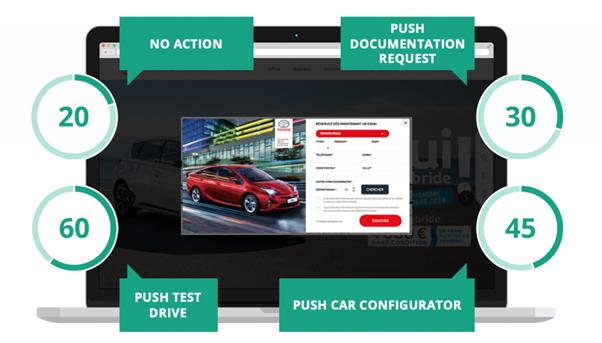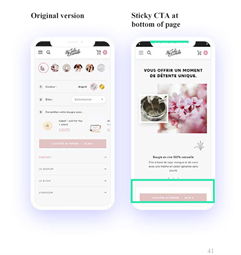
How to activate a data-driven testing and personalization strategy
Brands today have access to more data than ever before about the consumers that they are targeting. That’s why they need to put in place a data-driven marketing strategy on their websites for personalization to enable them to harness digital information and use it to better understand and meet customer needs, while increasing revenues and overall performance.
This blog outlines the benefits of a data-driven marketing strategy and highlights the key importance of personalization and A/B testing to success.
1 What is data-driven marketing?
Essentially, data-driven marketing uses customer data to create campaigns and activities that precisely meet the needs of individual consumers, thus improving their experience, increasing conversions and boosting revenues. Importantly it can be easily measured so that you can see the link between customer behavior and achieving your business goals.
In contrast, with traditional marketing, even the most informed and customer-centric campaigns have to make assumptions about the audiences that are being targeted, as they simply do not have the depth of data to truly understand customers and their needs. This leads to decisions being made based on guesswork, leading to campaigns failing and budgets being wasted on tactics and programs that don’t deliver results.
Data-driven marketing has evolved because of three factors:
- The rise of digital channels has provided access to detailed volumes of customer data that can be used to track, analyze and optimize customer interactions more effectively.
- Consumer expectations have transformed, with an increasing demand for a targeted, personalized customer experience from the brands that consumers engage with.
- The customer journey has shifted - it is no longer linear but involves multiple touchpoints and devices spread across a wide range of channels, which requires omnichannel experimentation.
Implementing data-driven marketing on your website and other digital channels is therefore vital if you want to outperform competitors and retain customers for the long-term by making better business decisions.
2 The benefits and challenges of data-driven marketing
Reaping the benefits of data-driven marketing
78% of marketers say that their use of data within their marketing programs has positively impacted conversion rates and sales.
By enabling you to target campaigns and activities based on data, rather than guesswork, brands are seeing the following benefits:
Reach customers more effectively through personalization
Today’s consumers demand a personalized experience - research from Kameleoon found that 75% of US consumers expect brands to personalize their journey. Delivering this at scale requires brands to embrace data-driven marketing, using the information they have to provide a tailored, relevant experience that improves the customer relationship. For example, understanding that a visitor to your website has specific interests means you can personalize content, messages and product recommendations to exactly meet their needs.
Equally, brands can use data to adapt offers and the experience, either around specific events or by using information such as location or device. For example, online tire retailer Allopneus runs successful campaigns to encourage visitors to invest in winter tires, based on their geolocation and current weather conditions. This data-driven approach has increased sales of winter tires by 3%.

Drive deeper engagement with customers through data
To ensure that consumers remain loyal over the long term lifecycle, brands need to engage with them on an emotional, rather than simply a transactional, level. This drives trust and enhanced brand perception, turning customers into advocates.
Embracing data-driven marketing is key to building this relationship, using insights to create personalized, emotionally-driven content and experiences that consumers are more likely to share and engage with. Data-driven marketing enables brands to achieve this at scale - meaning that even the largest corporation can engage successfully with thousands of customers, each with different needs and aspirations.
Visitors to the Toyota website have differing needs and levels of engagement - some are simply browsing or in the early stages of research while others are ready to take a test drive. By using AI-driven personalization, Toyota calculates the conversion probability of each visitor through the Kameleoon Conversion Score™ (KCS™):
- For hot leads (with a KCS of over 60) this then triggers a test drive request pop-in, personalized to the model they were looking at and their location.
- Visitors in the 45-60 range are offered the chance to personalize their vehicle through the online car configurator.
- Those showing some interest are offered a downloadable brochure.
- Visitors with the lowest conversion probability are left to browse uninterrupted.
This has led to a 97% increase in qualified test drive leads for Toyota and a halving of promotional costs.

An improved experience for all with experimentation
If a visitor walks into a store, you can measure their reaction to the experience - for example, are they put at ease by the decor and layout, what areas do they head to and what displays do they avoid or spend time browsing? This data can then be used to optimize the experience going forward to maximize the chances of a sale.
Data-driven marketing enables brands to deliver similar informed decisions and improvements to their digital presence - and allows them to go even further by running experimentation programs to test both major and minor changes to the experience and customer journey, enabling continual improvement. A/B testing provides reliable results on what best appeals to changing customer needs. This helps brands optimize their websites and online customer journeys to improve the experience for all and consequently increase conversions, achieving their ultimate business objectives.
On the My Jolie Candle website, the brand runs regular A/B tests to ensure that mobile UX is flawless. One of these looked at improving visitor navigation by inserting a sticky CTA, avoiding the need to scroll. This experiment led to a 17% increase in conversions on its mobile product information pages.

Ensure greater marketing efficiency
There’s a famous quote from retailer John Wanamaker - “Half the money I spend on advertising is wasted; the trouble is I don't know which half”. Traditional marketing techniques make it difficult to see what has driven increases in metrics such as conversions or revenues, meaning there is a significant risk that budgets are spent on ineffective tactics and campaigns.
With data-driven marketing you can precisely measure the success of campaigns and demonstrate the Return on Investment (ROI) of campaigns. That allows brands to focus their resources and reduce costs by only using tactics that are profitable and provide proven results. Marketers make better decisions and budgets go further, and deliver stronger, more measurable performance.
Understand and best use multiple channels
Analyzing customer data enables brands to better understand preferences when it comes to channels, enabling them to effectively target promotions and marketing campaigns. By having a view across every touchpoint you can see what appeals to consumers on specific channels or who arrive on your site from particular sources (such as a Google search or Facebook ad). This information is crucial to tailoring your strategy and optimizing conversion rates.
Essentially, with data-driven marketing, you can identify which channel performs best with specific audiences, helping you to best use your end-to-end multi-channel mix.
The challenges of data-driven marketing
For many brands, embracing data-driven marketing is still a new concept - ensuring that it drives success does mean overcoming three key challenges:
Gathering the right data - while retaining consent
Marketers now have access to unparalleled volumes of data - but this brings its own problems. Information could be siloed in different systems or departments, making it difficult to access or combine with other sources. At the same time consumers (and regulators) want greater control over how their data is stored and used, meaning brands need to follow clear policies around consent. That means the marketing systems you use must be compliant, open, and easy to integrate across your technology and martech stack, avoiding silos and supporting your digital strategy.
Being able to analyze and act on data in real-time
In a fast-moving world, brands need to be able to collect, analyze and act on data in real-time if they are to meet changing customer needs. That can be a challenge for companies that rely on combining data from multiple sources, such as their CRM systems, with ‘hot’ behavioral data from their websites. However, this hot, real-time data alone can be enough to accurately predict visitor behavior - without needing to add in other data sources. By using AI-based analytics tools, brands can therefore personalize the experience through data-driven insights in real-time, helping improve performance and increase conversions across marketing channels.
Creating a data-driven culture in your organization
This can be the hardest challenge to overcome, particularly in larger or more hierarchical organizations, where decisions have previously been made based on seniority and assumptions. Moving to a data-driven culture requires a change in mindset from everyone, from business leaders down. Education is key - start small and show the results and ROI from data-driven marketing projects and then scale it across your business. If necessary bring in external skills from agencies to help build your CRO team and embed cultural change in the company.
In an increasingly digital-first world, brands need to embrace data-driven marketing to ensure that they are successfully delivering the personalized experience that every visitor to their website is looking for - otherwise they risk lower engagement rates, conversions and ultimately revenues.





